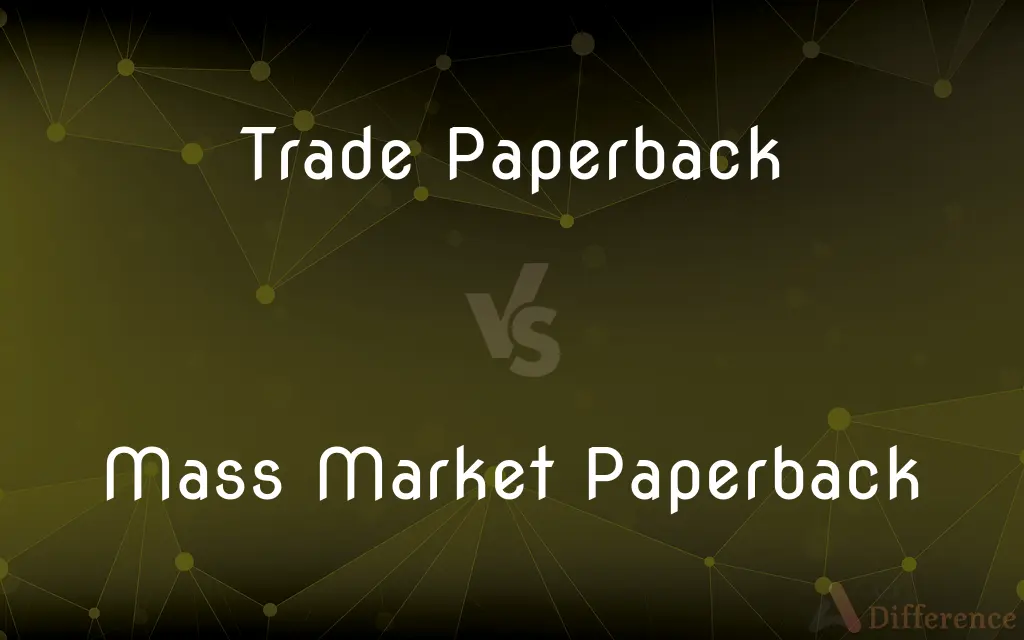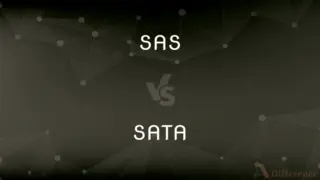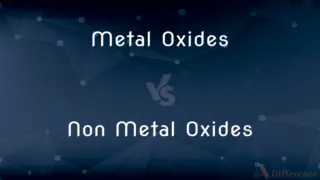Trade Paperback vs. Mass Market Paperback — What's the Difference?
Edited by Tayyaba Rehman — By Fiza Rafique — Published on December 17, 2023
Trade paperbacks are larger in size and often of higher quality than mass market paperbacks, which are smaller and typically cheaper.

Difference Between Trade Paperback and Mass Market Paperback
Table of Contents
ADVERTISEMENT
Key Differences
Trade paperbacks and mass market paperbacks are both types of softcover books, but they have distinct characteristics and purposes. The primary difference is evident in their physical attributes, price points, and distribution channels.
Trade paperbacks are typically larger in size and are printed on better quality paper. Often, they're the format publishers choose for books that have previously been released as hardcovers. When a hardcover book transitions to a more affordable and portable format, the trade paperback is frequently the choice. This format can be found in bookstores, both large and small, as well as in many libraries.
Mass market paperbacks, on the other hand, are smaller, usually pocket-sized, making them convenient for travel and commuting. The paper quality is usually not as high, and the binding can be less durable. These books are often priced lower than trade paperbacks, making them more accessible to a broader audience.
The distribution channels for mass market paperbacks differ from trade paperbacks. While trade paperbacks are commonly found in traditional bookstores, mass market paperbacks can be seen in non-traditional venues, such as supermarkets, drugstores, and airports. It's worth noting that while both types of books are meant for the general reading public, their size, quality, and price points are tailored for different market segments and distribution methods.
Comparison Chart
Size
Larger
Smaller, often pocket-sized
ADVERTISEMENT
Paper Quality
Higher
Lower
Price Point
Typically higher
Typically lower
Distribution
Bookstores and libraries
Supermarkets, drugstores, airports
Primary Audience
General readers, often following a hardcover release
Broader audience seeking affordability and portability
Compare with Definitions
Trade Paperback
A softcover book larger than a mass market edition.
The novel was first released as a hardcover, but the trade paperback came out a year later.
Mass Market Paperback
Often printed on lower quality paper with a less durable binding.
My mass market paperback got worn out after a few reads.
Trade Paperback
Found in traditional bookstore settings.
I browsed the local bookstore and picked up a few trade paperbacks.
Mass Market Paperback
Found in diverse retail settings, not just bookstores.
The supermarket had a rack of popular mass market paperbacks.
Trade Paperback
Often a follow-up format to hardcover releases.
Readers who missed the hardcover release eagerly awaited the trade paperback version.
Mass Market Paperback
A format that prioritizes portability and affordability.
For my daily commute, I always have a mass market paperback in my bag.
Trade Paperback
A mid-priced softcover option.
If you're looking for a balance between quality and price, consider the trade paperback.
Mass Market Paperback
A pocket-sized, affordable softcover book.
I grabbed a mass market paperback before my flight.
Trade Paperback
Printed on quality paper with a sturdy binding.
Many readers prefer trade paperbacks for their durability and paper quality.
Mass Market Paperback
Tailored for broad audience accessibility.
Mass market paperbacks are perfect for readers on a budget.
Common Curiosities
Are mass market paperbacks only sold in non-bookstore settings?
No, they're also available in bookstores, but they can be found in various retail settings.
Why might someone choose a trade paperback over a mass market edition?
They might prefer the larger size, better paper quality, or the book's design.
Which format is more popular?
It depends on the audience and setting. Mass market paperbacks are popular for casual reading, while trade paperbacks are preferred by many for quality and design.
Is there a difference in cover art between the two formats?
Sometimes. Mass market paperbacks might have different or more commercial cover art.
What's the main difference between a trade paperback and a mass market paperback?
Trade paperbacks are larger and of better quality, while mass market paperbacks are smaller and more affordable.
Can a book be available as both trade and mass market paperback?
Yes, many popular titles are released in both formats.
Are trade paperbacks always released after the hardcover edition?
Often, but not always. Some books are released directly as trade paperbacks.
Is the content different between the two formats?
No, the content is the same; only the format, size, and sometimes cover design differ.
Can I find academic texts as mass market paperbacks?
Less likely. Academic texts are often published as hardcovers or trade paperbacks due to their content and audience.
Do authors have a say in which format their book is published?
Typically, the publisher decides, but authors might have input, especially if they're well-established.
Why are mass market paperbacks cheaper?
They're smaller, often printed on cheaper paper, and are bound less durably.
Why are mass market paperbacks convenient for travel?
Their compact size makes them easy to carry and fit in bags or pockets.
Are all small-sized books mass market paperbacks?
Not necessarily. The term "mass market" refers more to distribution and pricing than just size.
Is the lifespan of a trade paperback longer than a mass market paperback?
Generally, due to better quality materials, trade paperbacks might last longer.
Why are trade paperbacks sometimes preferred by libraries?
Their durable construction and better paper quality often stand up to multiple readers better.
Share Your Discovery

Previous Comparison
SAS vs. SATA
Next Comparison
Metal Oxides vs. Non Metal OxidesAuthor Spotlight
Written by
Fiza RafiqueFiza Rafique is a skilled content writer at AskDifference.com, where she meticulously refines and enhances written pieces. Drawing from her vast editorial expertise, Fiza ensures clarity, accuracy, and precision in every article. Passionate about language, she continually seeks to elevate the quality of content for readers worldwide.
Edited by
Tayyaba RehmanTayyaba Rehman is a distinguished writer, currently serving as a primary contributor to askdifference.com. As a researcher in semantics and etymology, Tayyaba's passion for the complexity of languages and their distinctions has found a perfect home on the platform. Tayyaba delves into the intricacies of language, distinguishing between commonly confused words and phrases, thereby providing clarity for readers worldwide.
















































